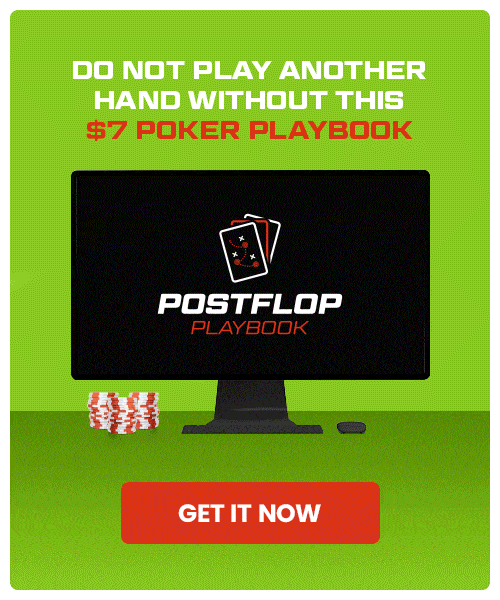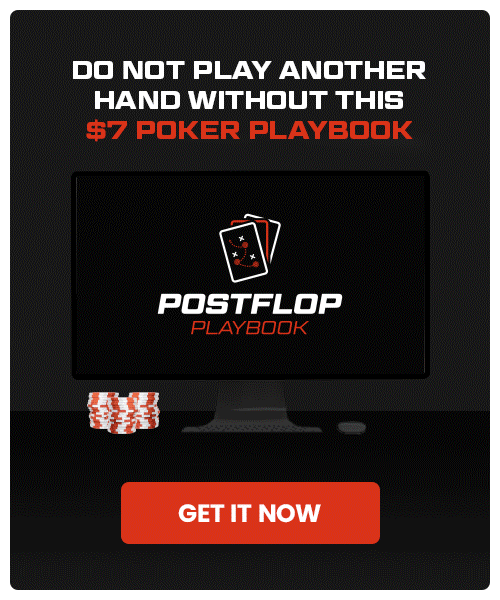How to Read Poker Hands in No Limit Hold’em (The Professional Way)
Hand reading is one of the most misunderstood concepts among casual poker players.
The mistake these casual players make is trying to put their opponent on one specific hand. That may make for good TV, but it’s not a practical or effective way to approach hand reading.
You’re about to learn the right way to read your opponent’s hands, which involves putting your opponents on a “range” of all hands they can possibly have.
Editor’s note: This article is marked as beginner. If you’d prefer some more advanced reading, check out our intermediate articles here or advanced articles here.
The Hand Reading Process Using Ranges
Hand reading is not easy. There is an awful lot of information you need to think about in a very short time-span, and every piece of information impacts your opponent’s possible range.
I like to call all these pieces of information “data points”. Here are a few examples of common data points:
- The position of you and your opponent.
- Your opponent’s bet size.
- The tendencies of your opponent.
There are a near-countless number of data points in poker, and nobody can consider every factor in the short time between decisions at the table — not even the best players in the world. This is why you need a simplified, effective process to follow, which is what you will learn today.
Let’s start by laying out the fundamentals of hand reading:
- Ranges get smaller as the hand progresses from preflop to the river.
- Whenever your opponent makes a decision, you can eliminate the hands from his range that don’t seem to fit that decision.
Now, let’s go through an example so you can see how to hand read street-by-street. (We’re gonna use a cash game example, but this process works just as well in tournaments.)
Note: Want to make more profitable decisions in 30 seconds or less at the poker table so you walk away with more money?
Get Doug Polk's $7 Postflop Playbook and learn an easy-to-use system for winning at poker and start turning those “I don’t know what to do here” spots into money-making situations.
Hand Reading Example: K♥ 8♥ in the Big Blind
Let’s say you’re playing a $0.50/$1.00 No Limit Hold’em game online. It’s your first hand at the table, so you have $100 in your stack and no reliable reads on your opponents.
The action folds to the player in the cutoff position who raises to $2.50. The button and small blind players get out of the way and you have K♥ 8♥ in the big blind.
We haven’t seen a flop yet, but we can already start the ranging process. There’s no way to know for sure exactly which hands he is raising with — the best we can do is estimate based on the information we have.
Since the player raised, it’s likely he has a strong or at least playable hand. But he also raised from late position, which likely means he has a relatively wide range of hands. We can estimate his range is 22+, A2s+, K7s+, Q8s+, J8s+, T8s+, 97s+, 86s+, 75s+, 65s, 54s, ATo+, KTo+, QTo+, JTo, visualized here:
Red = Raise | Blue = Fold
Note: As you can see, we’ve already eliminated a bunch of hands from your opponent’s range based on the fact that he raised. As the hand progresses, we will be able to eliminate more hands based on your opponent’s decisions.
K♥ 8♥ is an easy call considering you only have to call $1.50 to win $4 against this loose range of hands.
You defend your big blind with K♥ 8♥.
With $5.50 in the pot, the flop comes K♠ 5♦ 4♠. You check and the cutoff bets $2.
This is a pretty uncoordinated flop, though there are a few potential draws. On this flop texture, you should expect your opponent to make a continuation bet (c-bet) on this flop with a large portion of his range.
Now, we have to make some assumptions about how the cutoff plays in order to estimate his range. We will assume the cutoff:
- Bets with all strong hands (top pair or better)
- Bets with his most vulnerable pairs (such as 65 or 77)
- Bets with all flush draws and backdoor flush draws
- Bets with all straight draws and backdoor straight draws
- Checks with high pocket pairs below the King (QQ-TT)
- Checks with ace-high hands that don’t have flush potential
That range looks like this:
Red = Always Bet | Pink = Bet Only with Relevant Flush Card(s) | Green = Check | Blue = Not in Range
Against a range with so many bluffs and vulnerable pairs, you have a super easy decision versus a small bet with your top pair.
You call $2 on the K♠ 5♦ 4♠ flop.
With $9.50 in the pot, the turn is the 7♥. You check and the cutoff bets $7.
Again, we have to make some assumptions to estimate the cutoff’s range. He would probably:
- Bet with strong hands (top pair good kicker or better)
- Bet with flush draws and straight draws
- Check with the rest
That range looks something like this:
Red = Always Bet | Pink = Bet Only with Relevant Flush Card(s) | Green = Check | Blue = Not in Range
Against that range, you have 38.88% equity (click here to see the equity calculation). You only need 29.8% to profitably call based on your pot odds, so this is an easy call with top pair and a straight draw. To the river!
You call $7 on the K♠ 5♦ 4♠ 7♥ board.
With $23.50 in the pot, the river is the 2♠. You check and the cutoff bets $17.
Considering most of your opponent’s bluffs on the turn were spade flush draws, that does not seem like a river on which you can call a bet. Still, let’s estimate his range and see if there’s any way you can call here.
On this river, your opponent would likely:
- Bet with strong hands (sets, straights, and flushes).
- Bet with hands that missed their draw (Q8-98, A6, A2).
- Check with one pair and two pair.
That range looks like this:
Red = Always Bet | Pink = Bet Only with Relevant Flush Card(s) | Green = Check | Blue = Not in Range
You need 29.6% equity to profitably call this river bet, but K♥ 8♥ only has 26.83% equity versus the range above (click here to see the equity calculation). So, you should fold as this would be a slightly losing call against the estimated range.
I recommend trying this hand reading process a few times on your own, away from the table, before you try it in-game. It may take some getting used to, but I think you’ll find it quite easy and intuitive after a little bit of practice. (If you don’t have equity calculation software, you can click here to download Poker Equilab.)
Final Thoughts on Hand Reading
Poker is a game of incomplete information. The best players make sure that they are making the best decisions with the information available to them. Your job as a poker player is to extract, interpret, and prioritize the information available to you, and to formulate an optimal counter-strategy.
I hope this article has helped you improve your hand reading skills! If you have questions or feedback, don’t hesitate to leave a comment down below.
If you’ve ever been unsure when to quit a losing poker session, check out this article by Doug Polk next.
Take care!
Do Not Play Another Hand Without This $7 Tool
With such a low price tag, the $7 Postflop Playbook is a no-brainer if you want to nail down your fundamentals…
…and build a bigger bankroll.

